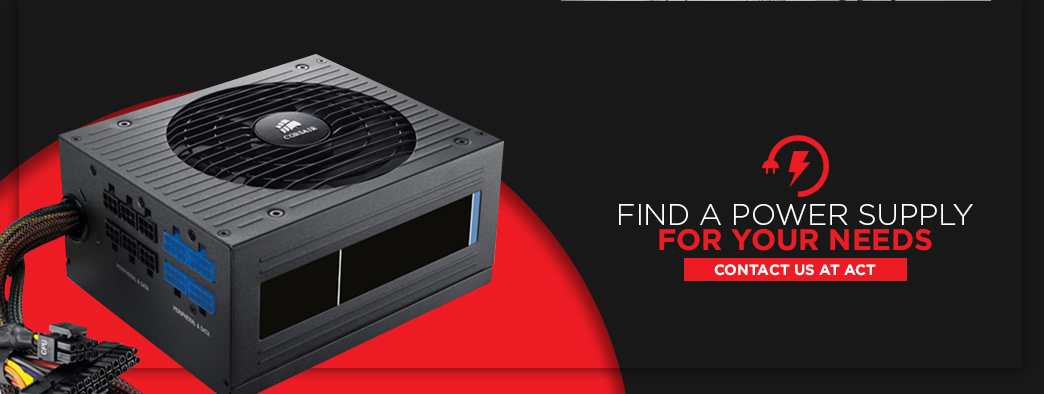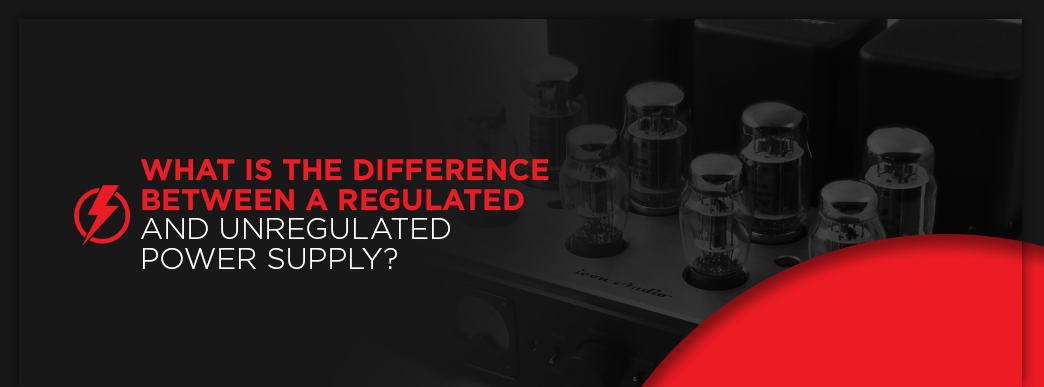
Quick Navigation:
- What Do Power Supplies Do?
- What is an Unregulated Power Supply?
- What is a Regulated Power Supply?
- Types of Regulated Power
- What is the Difference Between a Regulated and Unregulated Power Supply
- Which is Best for You: Unregulated Vs. Regulated Power Supply
- When You Need Unregulated Power Supplies
- When To Choose Regulated Power Supplies
Understanding the difference between a regulated and unregulated power supply will give you the information you need to choose which best serves your purposes. To start, you need to fully understand why you need a power supply and what you require it to do. From there, your intended use will help you choose whether a regulated or unregulated option will best serve your needs.
What Do Power Supplies Do?
Power supplies adapt the type of power available, either direct current, DC, or alternating current, AC, to the needed form and voltage for a specific use. Some will convert AC to DC power while others are DC-DC. AC to DC is the most common type because electrical devices use direct current, whereas the power supply from an outlet is in alternating current. DC-DC power supplies often convert power from a battery, such as a car battery, into the appropriate voltage for an electrical device.
In addition to converting the current type, power supplies must also change the voltage. AC voltage often needs to be reduced to a lower voltage for most electrical devices, though some applications may require different voltage levels. Converting the electricity to the required level is the task of the power supply’s transformer. All types of AC-DC power supplies include a transformer to make the electricity into a format the electrical device can use.
In addition to the transformer, all power supplies include rectifiers and filters. Power supplies can convert AC to DC power through rectification. Through changing from cyclical AC power to single-direction DC power, the amount of voltage can go through cycles. A capacitor filter in the power supply reduces these wild shifts, but it does not entirely smooth them out, leaving a ripple voltage in the power output. In unregulated power supplies, the voltage exits the device at this point. However, regulated power supplies have an added voltage regulator, which reduces the ripple voltage for even electricity from the supply. The exact operation of regulated power supplies depends on whether they are linear or switching.
Power supplies have two main categories — regulated or unregulated, depending on their output. If you select the wrong type, you could irreparably damage the device you need to power or pay too much for the power supply. Picking an unregulated power supply vs. regulated ranks as high as the voltage in terms of importance in operation and safety of the supply.
What Is an Unregulated Power Supply?
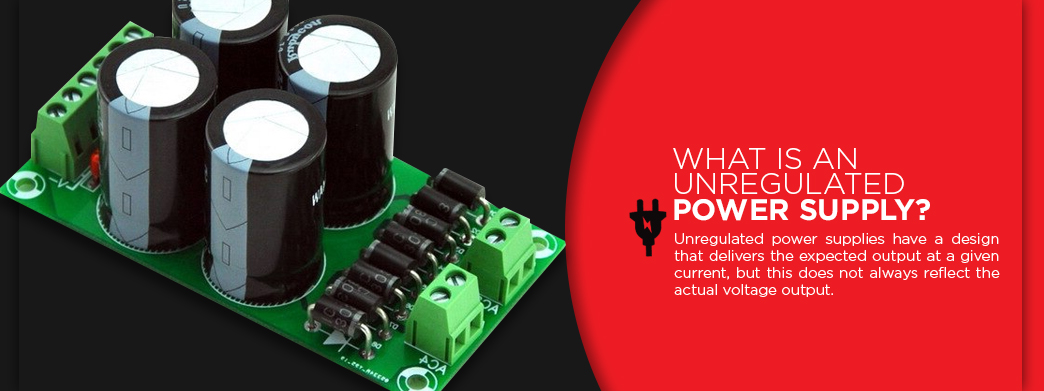
When electricity comes into a power supply, the output can fluctuate depending on the incoming voltage and the current amount the load draws, unless the supply has a means of regulating the voltage. Unregulated power supplies have a design that delivers the expected output at a given current, but this does not always reflect the actual voltage output. These power supplies are simple, low-cost options that have the major disadvantage of providing uneven voltage.
An unregulated power supply does not have the drastic increases and decreases in flow as it would have without a capacitor. The capacitor’s job of preventing severe swings in voltage helps, but this device does not create a perfectly clean output due to changes in both current load and voltage input.
Power equals the current times the voltage. If either the current or the voltage drop, the other variable increases to maintain steady power. While the energy from an unregulated power supply stays constant, the voltage output can drop or rise unexpectedly with a shift in the load current or the input voltage. Understanding how both input and output can affect the output is essential for deciding whether unregulated power supplies will suit your needs.
The slight changes in voltage output do not matter for some applications. For these uses, using an unregulated power supply can save you money. However, if you use one of these with electronics that require a consistent voltage, you could cause damage to the electronics or reduce its effectiveness. For such applications, you should use a regulated power supply like our 1446 or 2304.
What Is Regulated Power Supply?
A regulated power supply has all the same parts that unregulated supplies do but with the addition of a voltage regulator. This part ensures the output delivered is smooth and unchanging, regardless of draw or input. Delicate electronics require this consistency in electricity delivery, which makes regulated power supplies necessary for some functions.
Most regulated power supplies convert to DC power in addition to regulating the voltage. These AC-DC power supplies are popular because power outlets supply AC power, whereas many electronic devices use DC power.
Once you know you need power with low ripple voltage, you must choose the type of power supply. You have two options for regulated power supplies — linear and switching types. The differences between these forms of regulated power supplies depend on when the current changes from AC to DC.
Types of Regulated Power
Both AC and DC regulated power supplies provide clean, even voltage for the electronics they power. However, the method used to reach that voltage level changes depending on whether the power supply is a linear or switching model. Just as you can save money by choosing unregulated power supplies for appropriate uses over-regulated power supplies, linear power supplies can cost less than switching models. However, the output and other differences between these will make one a better choice for specific uses than the other. Don’t just choose the lowest cost. Consider how you will use the model and the output you need before selecting a linear or switching power supply.
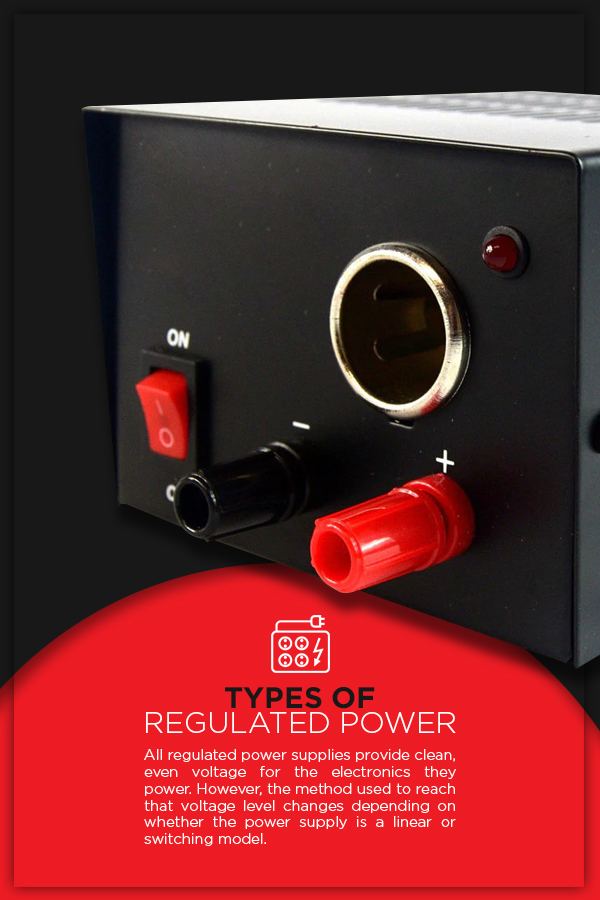
Linear Power Supplies
A linear power supply has the most straightforward method of stepping down voltage and regulating it. These only have a handful of steps to create the needed DC output with very low ripple voltage.
First, the incoming AC power goes through a transformer to step down. This lowered voltage is then ready for conversion from AC to DC power.
The next step in the process takes the stepped down power and puts it through a rectifier to convert to DC power. This converted power passes through a filter to smooth out the most significant changes in voltage.
Finally, the power supply sends power through a regulator to even out the voltage. The regulator prevents highs and lows of electricity from reaching the power supply’s output, providing clean, even power for the most sensitive of devices.
Due to needing fewer steps and parts, linear power supplies cost less than switching. However, these devices require more massive filters and transformers and are not as efficient as switching models. They also need manual adjustments for use with foreign power supplies.
Because linear power supplies operate quietly and work well for putting out lower power, they are ideal for communications, laboratories, and medical facilities that need quiet operation without requiring massive power output.
Switching Power Supplies
For highly efficient output for higher power situations, you will likely need switching power supplies. These supplies have a different method for changing from AC to DC power and regulating the voltage than linear devices. Switching power supplies are more complex but offer greater versatility. These power supplies also can step-up or step-down voltage per the device’s requirements.
First, switching power supplies rectify and convert power from AC to DC first. Changing the supply at the outset makes these systems more efficient and more adaptable. Unfortunately, the switching process can create additional noise, which may become a disadvantage in some situations.
Using pulse width modulation, or PWM, switching power supplies can adapt to various output needs. The regulated DC power then moves through a transformer to step down to the required levels. After that, it gets smoothed out again with capacitors and regulators. Despite the extra steps, switching power supplies are more efficient and more popular for today’s electronics that require even power with low ripple voltage.
Compared to linear, switching power supplies may cost more and make more noise, but they are smaller, more efficient, and capable of higher outputs. Manufacturers, those operating mobile stations, aviation managers, and ship operators are just some of those who choose the benefits of switching power supplies.
What Is the Difference Between a Regulated and Unregulated Power Supply?
The most significant difference between regulated and unregulated power supplies is the use of a voltage regulator. As the name suggests, this component evens out any ripple voltage in the voltage output. Some electrical components require having the expected voltage output consistent. Other types of electric parts can handle the minor ripple voltage in power from unregulated power supplies. If you must power general use electrical devices, such as LED lights, unregulated power supplies will work. But these power supplies are not for universal use.
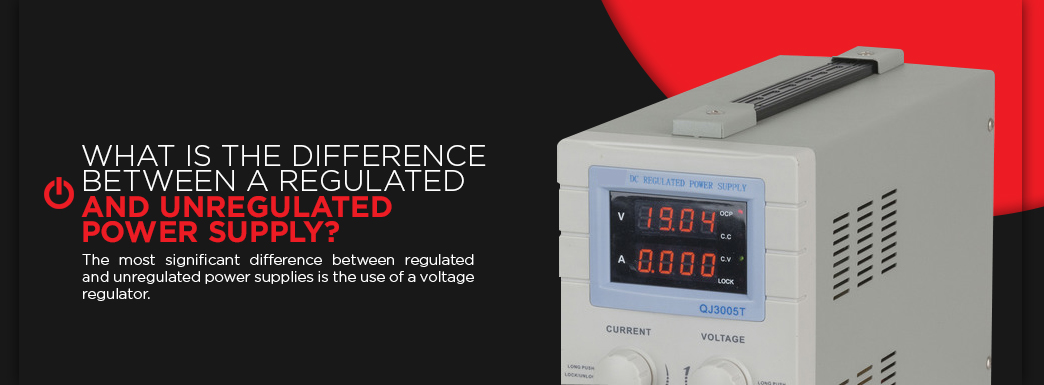
Adding a voltage regulator to a power supply increases the cost of the unit. If you do not need even power output, getting regulated power supplies may be too costly for your purposes. The cost differences become especially apparent when purchasing large numbers of power supplies. If you work with a tight budget, carefully consider whether you must have regulated power for your devices or not. Knowing the answer could save you money.
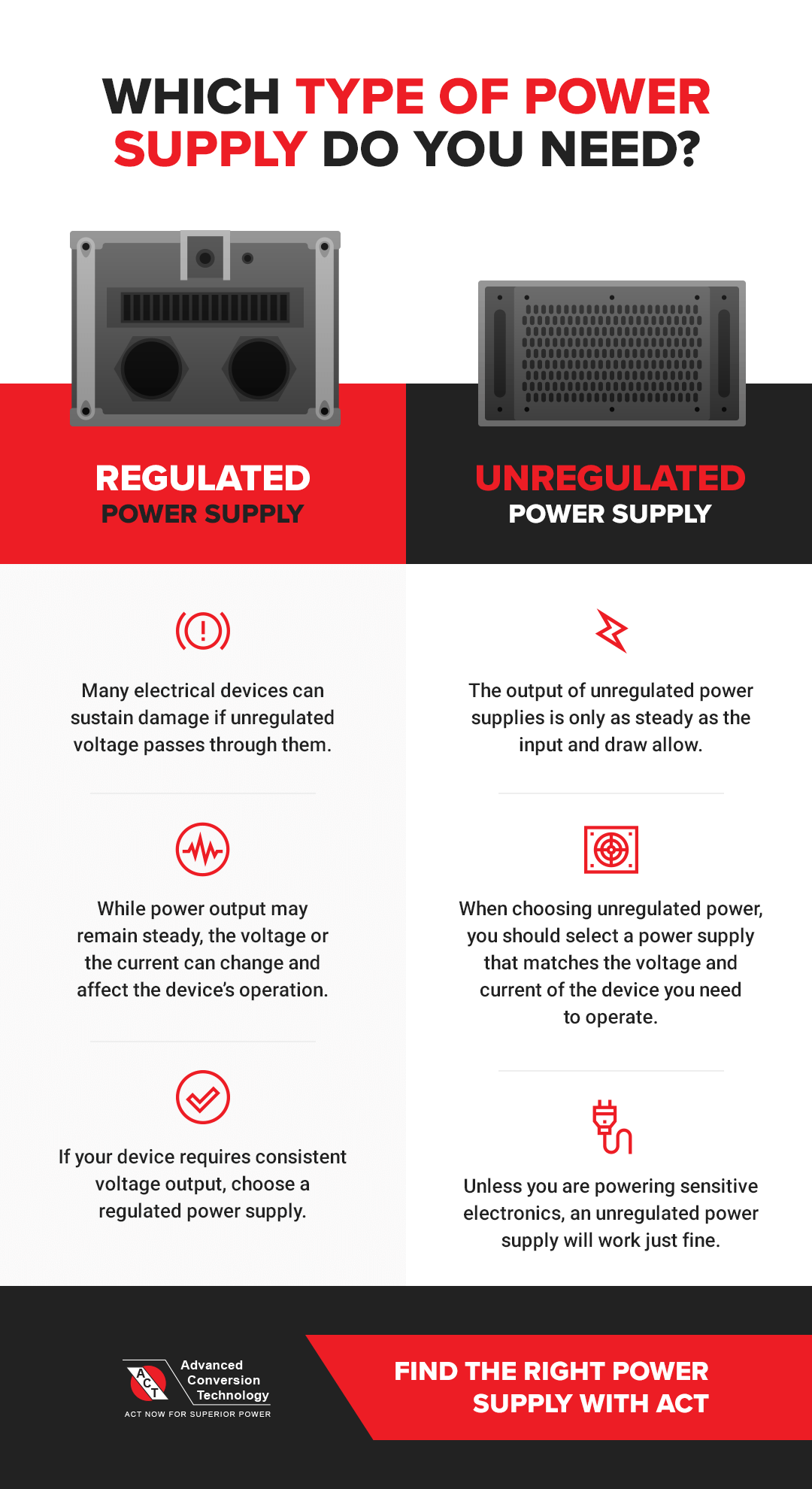
Which Is Best for You: Unregulated vs. Regulated Power Supply
Whether you need regulated or unregulated power depends on the devices you need to run. You can save money by ordering power supplies specifically for each device rather than selecting a bulk of only regulated or unregulated options. For example, just get regulated power supplies for those electrical devices that require clean, even voltage for operation. Purchasing unregulated power supplies for everything else can save you money.
When You Need Unregulated Power Supplies
The output of unregulated power supplies is only as steady, or clean, as the input and draw allow. When choosing unregulated power, you must select a power supply that matches the voltage and current of the device you need to operate. A mismatch could cause problems with the output delivered to the device or the power supply overheating from too much strain put on it.
Without a close match between the voltage from the power supply and what the device needs, the device could draw too much current — which would drop the voltage since power is the product of voltage and current. While power output may remain steady, the voltage or the current could change and affect the device’s operation. Electronics that have sensitive responses to voltage changes may sustain damage.
Many plug-in wall outlets are unregulated power supplies, though you can also find a few regulated power supplies in this format. Generally, lamps, LED lights, and DC motors are applications that do not sustain damage from minor voltage changes. Unless powering sensitive electronics and using a device with a consistent draw, unregulated power supplies will suffice. Because they lack a regulator, choosing these when needed can reduce your costs.
When to Choose Regulated Power Supplies
For some equipment, you will not have the option of choosing unregulated power supplies. Computers, televisions, and other electronics can sustain damage if too much power comes through. These electronics require a smooth voltage which is one of the advantages of regulated power supply. Such a requirement is so prevalent in modern electrical devices that almost all electronics today need regulated power supplies to prevent damage.
Choosing regulated power supplies is not the last decision you will need to make, though. You must also decide whether you need linear or switching. Both have multiple applications. Linear models cost less and are quieter, but they are not as efficient and are more substantial than switching power supplies. Switching may cost more than linear, but their increased efficiency and potential output make up for this.
Linear power supplies are better suited for use in specific applications than switching. The differences between these types of regulated power supplies can make choosing the right one a little easier:
- Linear: Linear regulated power supplies work best when you need lower output and quiet operation. Examples include laboratory test equipment, medical equipment, communications equipment, computers, control circuits, and data acquisition devices.
- Switching: Switching power supplies are ideal for general use overseas because these supplies have the versatility to adapt to different main power supplies. Additionally, many industries choose switching power supplies for regular use to provide the required voltage to their equipment, especially when they need higher power than a linear device can provide. You will find switching power supplies used for DC motors, aviation, research and development, manufacturing, shipboard applications, waste treatment, and many other sectors.
Find a Power Supply for Your Needs
Now that you know how regulated and unregulated power supplies work and their differences, you can make an informed decision when selecting the best option for your application. At ACT, we have a selection of both DC-DC and AC-DC power supplies created for the most rugged environments at affordable costs. People have used our power supplies for a variety of applications, such as communications, ships, ground vehicles, aerospace technology, and much more.
If you cannot find the power supplies you need, contact us at ACT, and we can design a product to fit your application-specific power requirements. We excel at providing quality, durable, reliable, and high-performance power solutions for a variety of industries and applications. See what we can do for you.
